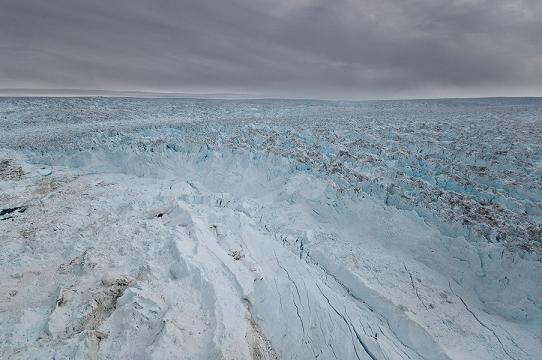Greenland glaciers debunk worst-case sea level scenarios

Like so much of climate science, the latest insight from the frozen world of Greenland offers one of those good news/bad news outlooks for the future of the world’s oceanfront real estate.
A decade-long, eye-in-the-sky study of nearly 200 major outlet glaciers found that they haven’t been tumbling into the ocean with the dramatic acceleration once feared — and that means these colossal rivers of ice might not contribute as much to a catastrophic sea-level rise as predicted by some worst-case scenarios.
Some climate studies had suggested that Greenland’s coastal glaciers were poised to produce enough fresh water to raise the global sea level by 2.5 to 6.5 feet over the next 90 years.
But their tidewater meltdown — if it doesn’t speed up beyond the rates seen during the past 10 years — will likely deliver a sea level boost measured in inches rather than feet, according to a new study published this week in the journal of Science.
“Our wide sampling of actual 2000 to 2010 changes shows that glacier acceleration across the ice sheet remains far below (the high-end) estimates, suggesting that sea level rise associated with Greenland glacier dynamics remains well below the low-end scenario (of about four to five inches by 2100) at present,” wrote lead researcher Twila Moon and three co-authors.
Much still unknown about Greenland ice
Still, there’s enough uncertainty in the outlook — 21st-Century Evolution of Greenland Outlet Glacier Velocities — to put coastal denizens on alert.
“A decade-long record of nearly all of Greenland’s major glaciers suggests that Earth’s sea level may not rise 2 full meters over the next century, as some recent studies have suggested,” the scientists added in a summary. “However, if ice loss in that region continues to accelerate, then sea level could rise 0.8 meters by 2100.”
Moon, a graduate student and Greenland ice velocity specialist at the University of Washington, cautioned that much remains unknown about Greenland ice.
“We don’t have a really good handle on it and we need to have that if we’re going to understand the effects of climate change,” she said in a story about the work. “We are going to need to continue to look at all of the ice sheet to see how it’s changing, and we are going to need to continue to work on some tough details to understand how individual glaciers change.”
The shrinking of the world’s glaciers in places like Alaska, as well as the mammoth ice sheets of Greenland and Antarctica, sends almost unfathomable volumes of fresh water into the ocean. Add it all up, and 21st century ice melt has the potential to directly raise the sea level enough to flood coastal zones and displace millions. As a result, estimating how fast the world’s terrestrial ice might transform into liquid water has become one of the most important and challenging tasks of climate science.
Sea levels were hundreds of feet lower during the height of the last ice age, when continental glaciers locked up vast quantities of water. The disintegration of that ice beginning about 14,000 years ago released enough water to boost sea height to near the current levels over thousands of years. Since the 1800s, however, new climate warming has been melting what’s left of the world’s ice, and sea levels have continued to sneak higher — maybe more than seven inches since 1900.
Future warning
Take into account all factors — expansion of sea water as it warms, disintegrating mountain glaciers, the shrinking ice sheets of Greenland and Antarctica — and global sea level may still surge another couple of feet by 2100, and possibly another 70 feet during coming centuries, according to a recent paper in the journal of Geology. Even if no one alive today will see it, a catastrophe appears to be looming unless global warming abates or something else changes, many researchers warn.
“You don’t need to sell your beach real estate yet, because melting of these large ice sheets will take from centuries to a few thousand years,” explained Rutgers geologist Kenneth Miller in this story. “The current trajectory for the 21st century global rise of sea level is 2 to 3 feet (0.8 to 1 meter) due to warming of the oceans, partial melting of mountain glaciers, and partial melting of Greenland and Antarctica.”
In a perspective essay titled “Regional Sea-Level Projection”, appearing in the same issue of Science, Josh Willis of the Jet Propulsion Laboratory and John Church with the Centre for Australian Weather and Climate Research warn that scientists must investigate sea level rise and make more precise estimates before it’s too late.
“Without adaptation, a rise by (20 inches) would displace 3.8 million people in the most fertile part of the Nile River Delta,” they wrote. “A rise by (6.5 feet) could displace 187 million people globally. Credible projections of sea-level rise in the 21st century are essential for devising adaptation or mitigation measures. Yet, present estimates of future sea-level rise are too imprecise to inform such decisions.”
This newest study led by Moon focused specifically on the velocity of Greenland’s big-dog outlet glaciers as they flow toward their crackling oblivion in the ocean — a small, but significant piece of the world’s total ice-destruction prospects.
The faster these glaciers move, the more ice and meltwater they ultimately add to the sea. In previous studies, scientists have conjured scenarios where Greenland glaciers doubled this rush toward destruction, or even accelerated tenfold, with sea level rising anywhere from four to 19 inches by 2100 as a direct result. But no one knew for sure how fast the glaciers were actually traveling in the real world.
In the new study, funded by NASA and the National Science Foundation, Moon and team took a detailed glimpse at most of Greenland’s 206 biggest glaciers. Using three satellites, the scientists examined glacier motion in the winter of 2000-01 and then repeated the process for each winter from 2005-06 through 2010-11. Based on data from 178 glaciers between 2000 to 2005, and another 195 observed between 2005 and 2010, they found that the velocity of these colossal ice rivers had not surged as much as some studies projected.
“In some sense, this raises as many questions as it answers. It shows there’s a lot of variability,” explained co-author Ian Joughin, a glaciologist in the UW’s Applied Physics Laboratory and Moon’s doctoral adviser. “We can’t look at one glacier for 100 years, but we can look at 200 glaciers for 10 years and get some idea of what they’re doing.”
Further research needed
The results were complicated. The story about the research explains further.
“Nearly all of Greenland’s largest glaciers that end on land move at top speeds of 30 to 325 feet a year, and their changes in speed are small because they are already moving slowly. Glaciers that terminate in fjord ice shelves move at 1,000 feet to a mile a year, but didn’t gain speed appreciably during the decade.
“In the east, southeast and northwest areas of Greenland, glaciers that end in the ocean can travel seven miles or more in a year. Their changes in speed varied (some even slowed), but on average the speeds increased by 28 percent in the northwest and 32 percent in the southeast during the decade.”
The scientists cautioned that 10 years was too short of a window to pin down the long-term dynamics of Greenland’s ice. Monitoring and research must continue. With more data, and a longer horizon, Greenland’s contribution could surprise us all. (And not in a good way.)
“So there still may be future events — tipping points — that could cause large increases in glacier speed to continue,” explained co-author Ian Howat, an assistant professor of earth sciences at Ohio State University. “Or perhaps some of the big glaciers in the north of Greenland that haven’t yet exhibited any changes may begin to speed up, which would greatly increase the rate of sea level rise.”
Contact Doug O’Harra at doug(at)alaskadispatch.com
For more stories from Alaska Dispatch, click here



